![[NEWS AND FACTS BANNER]](/URClipArt/news/titleNewsFactswide.jpg) |
|||||||||||||||||||
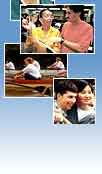
|
|||||||||||||||||||
Features
Innovation at Rochester:
|
|||||||||||||||||||
G – L |
G
Giving Back: Wilson Days
In the late 1980s, Theresa Guenther ’90 had an idea for a way to involve students in the life of Rochester’s community: a regular, University-wide day of service.
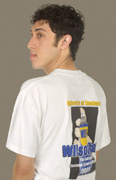 |
Lioy |
“I thought that anything we could do to give students another experience would be enormously helpful to them,” says Guenther, now a Legal Aid attorney in Buffalo.
Approaching its 15th anniversary this fall, the day (named after Joseph C. Wilson ’31, founder of Xerox and former chairman of the Board of Trustees) has become a keystone of orientation for College freshmen. And it continues to grow.
Last fall, student director Dan Lioy ’04 (T5) added another innovation: The event expanded to two days so that students could get a better sense of the community in which they live. Says Lioy: “If we’re trying to graduate students who are active citizens, we have to encourage them not to be isolated from the people around us.”
H
Hib Vaccine
Few scientists can claim credit for the near disappearance of a disease.
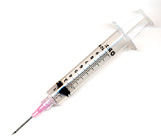 |
But thanks to vaccine technology developed by three Rochester researchers, infections caused by the bacteria Haemophilus influenza type b (Hib)—once the leading cause of meningitis in preschoolers—are nearly nonexistent today. The same technology, invented by the Medical Center team of David Smith, Porter Anderson, and Richard Insel in the 1980s, is helping stop other invasive infections as well.
“During my training in the 1970s, you could walk into any pediatric ward anytime and guarantee that there would be at least one child with invasive Haemophilus influenzae,” says Insel, the director of the University’s Center for Human Genetics and Molecular Pediatric Disease. “Now, there are so few cases, a doctor will go years without ever seeing one case.”
Licensed to the pharmaceutical giant Wyeth, the basic research behind the technology was later used to develop the company’s Prevnar vaccine, introduced in 2000.
Last spring, the New England Journal of Medicine reported that Prevnar had reduced the rate of infection from pneumococcal bacteria, which causes meningitis, ear infections, pneumonia, and other maladies, by 69 percent over three years.
I
Integration of Mind and Body:
Biopsychosocial Medical Model
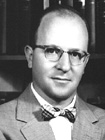 |
Engel |
“We are just as interested in what’s going on at the family level as we are in what’s going on at the cellular level,” Medical Center psychiatrist George Engel once said of his pioneering concept of medical education. “And we see all these things as interrelated.”
Together with John Romano, the founding chair of the Department of Psychiatry, Engel developed a medical education curriculum that combines training in medicine and psychiatry—an approach known as the biopsychosocial model—that has revolutionized medicine and related disciplines.
First put forward 50 years ago, the notion of exploring both the psychological and social aspects of illness and integrating that understanding with knowledge about the biological dimensions of disease processes continues to influence new generations of doctors.
J
Joining Music with Technology and Teaching
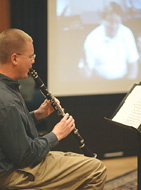 |
In the first such test of the latest in Internet technology, the Eastman School of Music and the Royal Scottish Academy of Music and Drama in Glasgow, Scotland, teamed up for real-time, intercontinental classes that both institutions hope will help refine the use of distance technology in performance training.
An initiative of the Eastman School’s innovative Institute for Music Leadership, the Internet-based partnerships continued last spring with a new connection between student musicians on Gibbs Street and musicians from the New World Symphony in Miami.
K
Vitamin K: A Nobel Discovery
 |
Here’s another reason to eat your greens: Dark-green vegetables like spinach and broccoli are potent sources of vitamin K, an essential component of blood-clotting discovered by Rochester researcher Henrik Dam.
The Copenhagen-born Dam first discovered the vitamin in the early 1930s as a scientist working in Denmark and Germany and was conducting research at the Medical Center in 1943 when he was named a cowinner of the Nobel Prize in medicine.
In a 1946 lecture to recognize his selection as a laureate, Dam noted that the “k” of vitamin K stands for “koagulation,” the Scandinavian and German spelling of coagulation. That, and the letter had not yet been taken for any other vitamins.
L
Laboratory for Laser Energetics
It is a place that specializes in science at the extremes of power, energy, density, pressure, and speed. In the futuristic, football-field-sized “clean room,” researchers conduct experiments involving energy levels many times those generated by the entire electrical capacity of the United States.
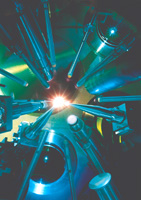 |
Founded in 1970 at Rochester—in part to draw on the University’s established record of innovation in optics—the Laboratory for Laser Energetics serves as an international center for research, training, and education in high-power lasers, fusion, and high-energy density physics.
One of the largest research centers at the University, the lab is home to Omega, the most powerful ultraviolet laser in the world and a key tool in the search for ways to use fusion as a sustainable energy source.
An extension to be completed by 2005 will allow the facility to fire briefer laser pulses at a dozen times the power of the current system, opening the door to even greater scientific exploration.
| SEARCH: Directory | Index | Contact | Calendar | News | Giving | |||